Bulletin – June 2015 Global Economy Wealth Management Products in China
- Download the article 296KB
Abstract
Wealth management products (WMPs) in China are investments that offer fixed rates of return well above regulated interest rates for deposits and are often used to fund investments in sectors where bank credit is restricted. They are typically actively managed by banks, with other firms commonly used as ‘channels’, but few are recorded on banks' balance sheets. A key concern about such products is the moral hazard created by a history of banks bailing out unguaranteed WMPs.
Introduction
Chinese WMPs are investment vehicles marketed to retail and corporate investors and sold by both banks and non-bank financial institutions (NBFIs), sometimes with explicit principal or interest guarantees. They differ from conventional mutual funds in that their returns are fixed and the products have a set maturity (which is usually fairly short). However, WMPs are also distinct from bank deposits in that the funds raised are invested in a range of loans and securities and the returns offered significantly exceed regulated deposit rates.
Issuance of WMPs has grown rapidly in recent years. The estimated stock outstanding exceeded CNY17 trillion as at 30 June 2014 (around 26 per cent of GDP; Graph 1).[1] Our estimate is likely to understate the stock of WMPs outstanding as it only captures WMPs that have either ‘active’ bank involvement (‘bank WMPs’) [2] or involve trust companies, which are financial institutions that manage assets and make investments on behalf of clients. The strong growth in WMPs in recent years has been supported by the higher yield they offer investors compared with the regulated ceilings on deposit rates, and a desire among banks to obtain funding beyond that possible at the deposit rates they can offer.
This article discusses the risks associated with WMPs in China and who is exposed to these risks. In order to understand the risks, it is necessary to recognise how the riskiness and investor exposure to underlying assets vary across different types of WMPs.
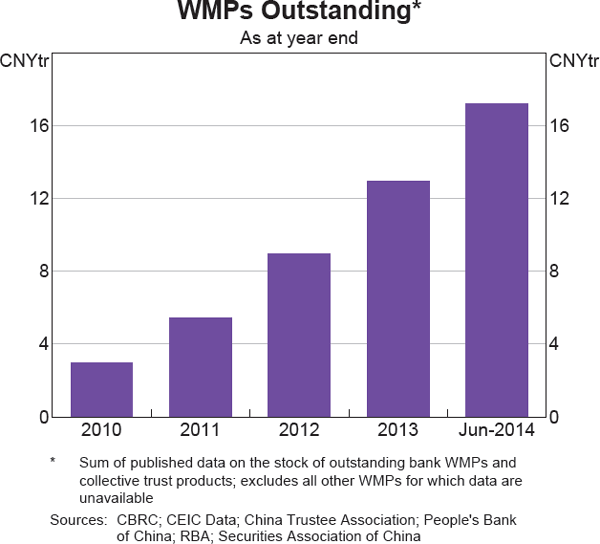
Types of WMPs
WMPs can be categorised according to the financial institutions that are involved in their issuance. Banks may raise and invest WMP funds themselves or use another financial institution, a so-called ‘channel’ firm, to make the investments; the latter is usually done in order to keep WMPs off banks' balance sheets and thereby avoid many regulatory requirements. In most cases where it uses a channel firm, the bank still has an active role – that is, the bank retains control over the investment decisions – and the channel firm acts as a passive administrator. Some WMPs are also set up by NBFIs without active bank involvement, though the product may still be sold by banks to investors.
As at mid 2014, 11 per cent of WMPs were estimated to have been developed and managed in-house by banks with no involvement from other financial institutions (‘pure’ bank WMPs; green area in Graph 2). Such products are most similar to deposits, but still offer yields higher than regulated deposit rate ceilings. This category of WMPs has explicit principal guarantees by the bank and is required to be accounted for on the balance sheet of the issuing bank.
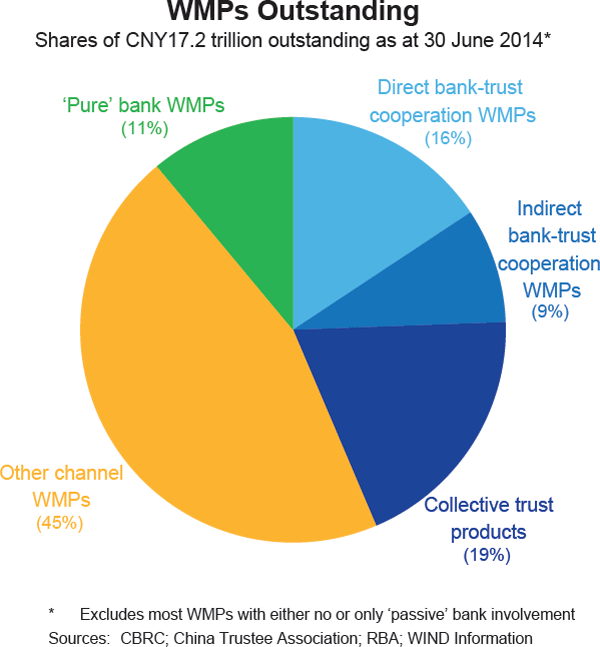
The remaining 89 per cent of WMPs were evenly split between those that use trust companies as channel partners and those that use other financial institutions as channels.
Among WMPs that involve cooperation between banks and trust companies, there are three main types – direct bank-trust cooperation products, indirect bank-trust cooperation products and collective trust products (the three blue shaded areas in Graph 2). Direct bank-trust cooperation products are the most straightforward, and were estimated to account for 16 per cent of the stock of WMPs outstanding. Funds raised by banks through such WMPs are placed in a newly created trust product with the bank as the sole investor, thereby creating a ‘single unit trust product’ (SUTP). Direct bank-trust cooperation WMPs are recorded on banks' balance sheets and the issuing bank explicitly guarantees the principal invested (and sometimes the interest as well). The bank remains the active decision-maker by directing the trust company to make specific investments (KPMG 2012). Reports suggest that trust companies' fee commission income is relatively low, which is consistent with their passive role in this business (Bedford and Rothman 2013).
In recent years, issuance of WMPs has shifted away from direct bank-trust cooperation products towards indirect bank-trust cooperation products, which accounted for 9 per cent of outstanding WMPs. Such products introduce a passive ‘bridge’ entity between the bank and the trust company. The bridge entity buys the trust product and then sells the claim on the returns of that product to a bank. The shift towards indirect bank-trust cooperation WMPs appears to be a response to regulations introduced by the China Banking Regulatory Commission (CBRC) requiring banks to bring all business with trust companies onto their balance sheets (CBRC 2010). This greatly reduced the incentive for direct bank-trust cooperation because it effectively required banks to guarantee the principal invested in these WMPs explicitly.
The third type of WMP that involves cooperation between banks and trust companies is known as a collective trust product (CTP; 19 per cent of outstanding WMPs). This category differs from the other two types of bank-trust cooperation products in that the trust company, rather than the bank, actively makes the investment decisions. CTPs are set up and managed by trust companies, and the units in the trust product are sold to wealthy individuals and corporate investors. Investors' funds are pooled and then generally invested in a single asset or asset type. There are relatively strict rules governing investment in CTPs: the minimum investment is CNY1 million; there can be no more than 50 individual investors in each product; and marketing is restricted to the home city of the product and no more than two other cities (Hu 2014). CTPs are not recorded on banks' balance sheets, and the role of banks is limited to being passive distributors by using their sales force and branch networks to attract investors. These WMPs can also be distributed through NBFIs.[3] Banks earn small distribution fees, while the profit margin on CTPs for trust companies is reportedly as high as 150–300 basis points, which is far greater than for direct and indirect bank-trust cooperation WMPs.
The remaining 45 per cent of WMPs were estimated to involve cooperation between banks and other financial institutions (mainly securities firms; orange area in Graph 2).[4] These WMPs are similar to direct bank-trust cooperation products, where the bank remains the principal decision-maker and the so-called ‘channel’ firm collects a small management fee for its role. However, data on bank WMPs organised through other financial institution channels are more limited. These WMPs are all assumed to be off the balance sheets of banks. Growth of this category of WMPs has been more rapid than that of bank-trust cooperation products, which is in part due to the less stringent regulation faced by non-trust financial institutions. Non-trust channel firms are also believed to charge lower management fees than trust companies, making them a cheaper partner for banks.
While in principle a wide variety of financial institutions could serve as channel firms, securities companies have recently become the most prominent competitor to trust companies. Securities firms offer vehicles known as targeted asset management plans, with CNY4.8 trillion outstanding as at the end of 2013 (Securities Association of China 2014). Insurance companies also act as channel firms for banks, though data on the size of this channel are not readily available.
There is a potentially large and rapidly growing stock of WMPs that are set up and actively managed by various NBFIs that have no bank involvement. However, data and information on this category of WMPs are limited and are not covered in this article.[5]
Links between Trust Company Assets and WMPs
The links between WMPs and trust companies are significant. As at mid 2014, trust companies were estimated to source 60 per cent of their assets under management through the issuance of WMPs (or CNY7.5 trillion;[6] Figure 1). The remaining CNY5 trillion were largely accounted for by financial institutions investing their own funds with trust companies.[7] In some cases, financial institutions use trust companies as intermediaries to make investments they cannot make themselves due to regulatory restrictions, such as banks extending loans to particular sectors (Green et al 2013). In these cases, banks retain the investment risk, as they do with guaranteed WMPs (shown in dark blue in Figure 1), though as discussed below it is not clear whether they will also absorb any losses on WMPs that are not legally guaranteed (those coloured orange in Figure 1).
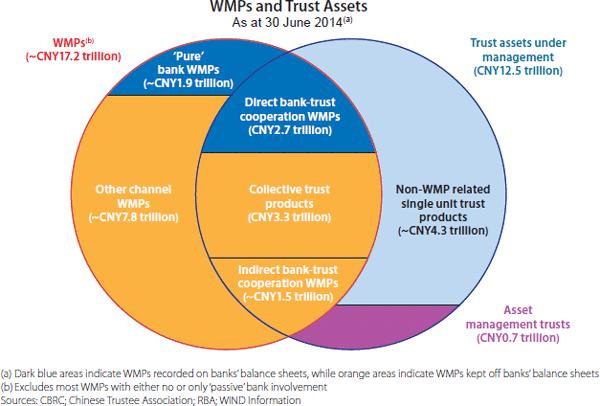
Risks Associated with WMPs
CTPs
CTPs differ from bank WMPs in important ways: their distribution is limited to wealthier investors; they tend to face fewer restrictions on their investment activity; and they typically have terms of between one and two years, though sometimes significantly longer. CTPs invest in a single asset or asset type and so do not have the diversification benefits of many other WMPs; in 2014 these assets were mostly loans or bonds (Graph 3).
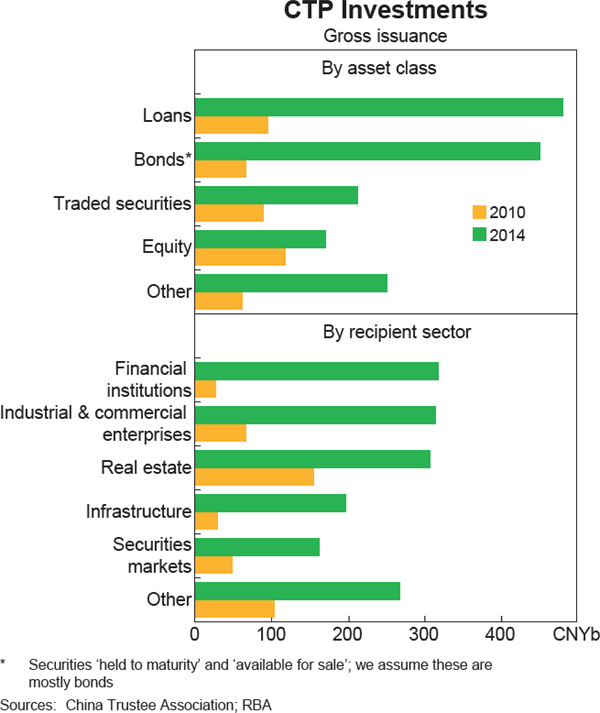
According to data from the Chinese Trustee Association (CTA), around two-thirds of CTP assets are invested in either financial institutions, ‘industrial & commercial enterprises’ or real estate, with the distribution between these three fairly even.[8] The latter two sectors include industries currently experiencing excess capacity and declining profitability, such as property development, coal extraction and solar panel manufacturing. There are also reasons to believe that these data may understate the underlying exposure of CTPs to property if some of the financing extended to financial and other enterprises is related to real estate financing or loans made to other sectors are collateralised by real estate, as is commonly believed.
Although CTPs result in undiversified credit risk, their disclosure of investment details is better than for other WMPs. Prospectuses outline the project or company being funded, the mechanism used to finance it and any credit enhancement structures, including pledged collateral and third-party guarantees provided. Nonetheless, some CTP investors have previously alleged that sales practices fell short of such disclosure and risks were misrepresented (see ‘Box A: The “Credit Equals Gold #1” Collective Trust Product Default’).
CTPs also tend to offer investors higher yields than other WMPs to compensate (at least in part) for the undiversified credit risk, with rates of return averaging around 8.5 per cent at the end of 2014 (Graph 4). This was around 350 basis points more than the average return on other types of WMPs and 600 basis points more than the regulated one-year benchmark deposit rate. Compensation for exposure to real estate and infrastructure projects appears to be a little higher than the average.
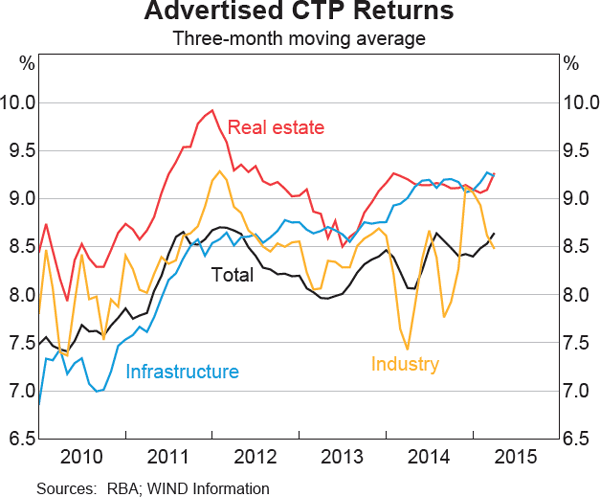
Risks in Bank WMPs
The risks posed by WMPs with active bank management differ from those inherent in CTPs owing to differences in their structures. ‘Pure’ bank WMPs have explicit principal guarantees and typically invest a higher share of assets in relatively low-risk investments, including government bonds, interbank loans and highly rated corporate bonds (Bedford and Rothman 2013). Other on-balance sheet bank WMPs (those with direct bank-trust cooperation) also have explicit principal guarantees and hence any risks are borne by the issuing bank. In contrast, investors in WMPs without an explicit guarantee legally bear the investment risk, though in practice banks may still absorb any losses.
We assume that data on the investments of SUTPs serve as a reasonable proxy for the investments of WMPs that are not legally guaranteed. On this basis, these WMPs invest in similar assets to CTPs (predominantly loans and bonds). The investments of SUTPs tend to be a little less exposed to the property sector than those of CTPs (around 7 per cent of SUTP assets are directly invested in real estate) and a little more exposed to ‘industrial & commercial enterprises’ and infrastructure. An important distinction is that unlike CTPs, the investments of these WMPs are diversified across asset types.
Instead, a key risk of unguaranteed bank WMPs is the maturity mismatch between most WMPs sold to investors and the assets they ultimately fund. Many WMPs are, at least partly, invested in illiquid assets with maturities in excess of one year, while the products themselves tend to have much shorter maturities; around 60 per cent of WMPs issued have a maturity of less than three months (Graph 5). A maturity mismatch between longer-term assets and shorter-term liabilities is typical for banks' balance sheets, and they are accustomed to managing this. However, in the case of WMPs, the maturity mismatch exists for each individual and legally separate product, as the entire funding source for a particular WMP matures in one day. This results in considerable rollover risk and could force banks to use their ownfunds to repay investors as WMPs mature, effectively bringing them onto their balance sheets.
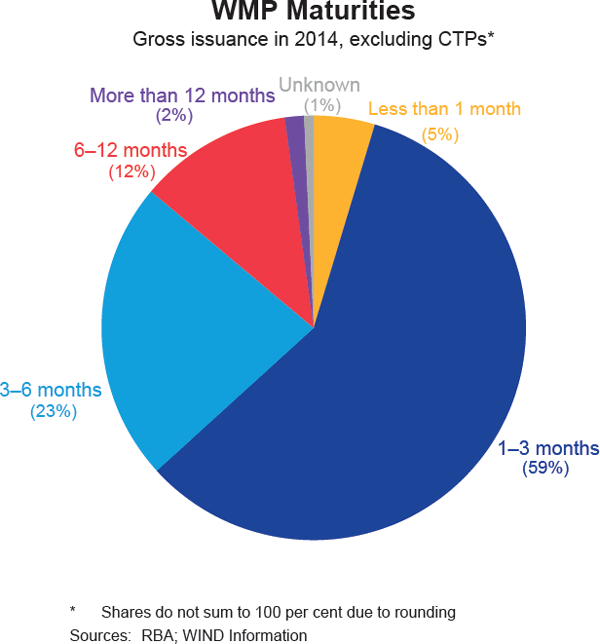
Box A: The ‘Credit Equals Gold #1’ Collective Trust Product Default
There have been no verified reports of bank WMPs failing to repay investors. However, in several high-profile instances CTPs have failed and these provide useful case studies of the approach of Chinese institutions and authorities to defaults. The most prominent such event concerned a CTP called ‘Credit Equals Gold #1’.
In January 2014, media reports confirmed that this product, set up by the China Credit Trust Company and marketed by the Industrial and Commercial Bank of China (ICBC), had failed. This product was issued in 2010 and raised approximately CNY3 billion for the Zhenfu Energy Group, a mining company based in Shanxi province. The CTP was intended to yield 10 per cent per annum and had a maturity of three years. The financing provided was effectively a collateralised loan; Zhenfu's shareholders sold 49 per cent of the company to the trust product and pledged to buy back this stake at maturity. They also invested CNY30 million in the product directly.
However, Zhenfu ran into legal problems regarding its other fundraising practices and, as investigations continued, most of its mining operations were suspended. As a result, the company was unable to repay the trust product upon maturity. Investors in the product lodged their complaints with ICBC and alleged that they had not been properly informed of the risks and that sales personnel had effectively portrayed the investment as guaranteed.
Ultimately, the investors were reimbursed their principal in full, though it is unclear whether investors incurred minor interest losses. ICBC initially asserted that it was not responsible for the product directly, but came under increasing pressure from investors. The authorities appear to have pushed the bank to find a solution to the problem. It reportedly extended a loan to Huarong Asset Management Company, which is one of the four large asset management companies founded in the aftermath of the 1997 debt crisis to acquire non-performing assets (Anderlini and Wildau 2014). Huarong reportedly used the funding to purchase the stake in Zhenfu from the CTP at around 95 per cent of its face value, allowing investors to be reimbursed.
These events illustrate the difficulties of accurately assessing risks arising from WMP investments. Although ICBC had only been marketing the product and had no legal responsibility for its performance, it was compelled to organise a rescue, which ensured that investors did not lose their principal. These forms of contingent liabilities are not recorded on banks' balance sheets. Nonetheless, the history of bailouts has reportedly led to the common investor perception that CTPs, and unguaranteed WMPs more generally, are implicitly guaranteed by the issuing bank or the government.
Another concern flagged by Chinese authorities relates to banks engaging in a practice known as ‘pooling’. Pooling refers to a bank combining funds raised through separately issued WMPs into a single pool of funds and investing it as one portfolio. In 2013, the CBRC banned banks from pooling WMP funds, requiring them instead to map WMPs to their investments one-to-one (CBRC 2013). However, to date not all banks have ceased to operate WMP pools, probably because they are operationally easier to manage and it takes time to change systems and operations.
A lack of transparency in many parts of the WMP sector may also mean that investors do not have the information to price these risks correctly. WMP prospectuses issued by banks generally feature only generic statements informing potential investors that the products are not deposits and carry investment risks, and they assign a standardised risk rating. However, there is little useful information about which investments will be funded, the indicative portfolio allocations are extremely general and asset class descriptions are limited.
Moreover, a pattern of WMP bail-outs overseen by Chinese authorities and financial institutions has apparently led many investors to regard all WMPs as implicitly guaranteed and risk free, despite the contrary legal status (see ‘Box A: The “Credit Equals Gold #1” Collective Trust Product Default’). As there is no track record of ‘unresolved’ WMP defaults, banks are reluctant to be the first to default on a product which they have issued. Chinese authorities have frequently noted their concern about the resulting existence of moral hazard issues in (some of) China's financial markets (PBC 2014, p 155).
The pricing of bank WMPs – that is, excluding CTPs – supports the notion that investors largely perceive these predominantly unguaranteed WMPs as being guaranteed by banks (which in turn are often presumed to be backed by the government). In particular, the returns offered on both unguaranteed and guaranteed WMPs track money market rates fairly closely, which could mean that investors believe they are essentially gaining exposure to banks rather than the underlying assets (Graph 6). Further, the yield spread between unguaranteed and principal-guaranteed WMPs has been stable over recent years and is notably smaller than credit spreads between banks and riskier borrowers in China (Graph 7). For example, the size of the spread is similar to that between bonds issued by state-owned banks and other large, often state-owned, companies in China.
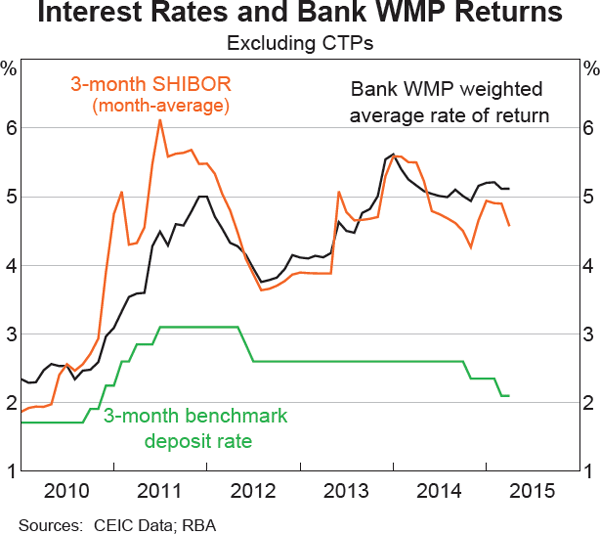
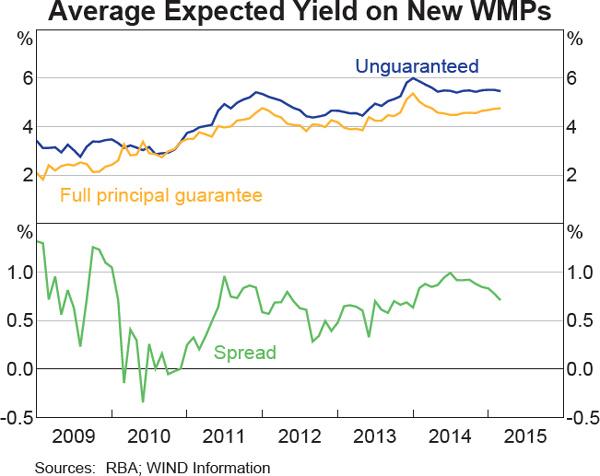
If banks were to compensate investors in the event of a default, their partners in WMP issuance are unlikely to be able to share this burden, as most channel firms, including trust companies, appear to have relatively low levels of capital and limited fundraising capabilities. The ratio of shareholders' equity to assets under management is around 2 per cent for trust companies. The recent introduction by the CBRC of a fund aimed at supporting troubled trust companies may, however, reduce the burden on banks in selected circumstances by providing a clearer mechanism for managing distressed trust assets.[9] The capacity of securities firms and fund management subsidiaries to absorb losses on WMP investments is likely to be lower still.
While it is difficult to evaluate the size of unreported contingent liabilities arising from off-balance sheet WMPs, the estimated stock of WMPs within our coverage as at 30 June 2014 amounted to 11 per cent of total banking system assets (and 16 per cent of total deposits), of which three-quarters is not legally guaranteed. Using our estimate of total WMPs outstanding as at the end of 2013, more than a quarter of these WMP assets would have to fail before the aggregate Common Equity Tier 1 capital ratio of the banking system fell below the 5 per cent minimum designated by Chinese banking regulators.[10] However, this presumes that banks would have access to sufficient liquidity to meet such claims; capital ratios could fall further in the event of declining asset values and ‘fire-sale’ dynamics.
This exercise also does not include losses incurred on bank assets not related to WMPs, which would also be likely to increase in times of stress. Moreover, while smaller Chinese banks (i.e. not state-owned or joint-stock commercial banks) generally report capital ratios that are well above the Basel III minimum requirements, they accounted for around 45 per cent of WMPs issued in 2014 and therefore have more significant off-balance sheet exposures relative to their capital.
Conclusion
Wealth management products have become a sizeable and important feature of China's financial system. Banks have a central role in the issuance of WMPs and retain control of the investment decisions for a large proportion of products. While it is difficult to obtain precise figures, our estimates suggest that the stock of outstanding WMPs was at least CNY17 trillion as at 30 June 2014, and that the majority of these were invested in loans or debt securities. WMPs invest in a wide range of industries, including industries that are vulnerable to weak property market conditions or those experiencing overcapacity. Most WMPs are not explicitly guaranteed by the issuing bank so investors legally assume the risk of these products. A key issue is whether the presumption of implicit guarantees is upheld or the authorities allow failing WMPs to default and investors to experience losses arising from these products.
Footnotes
The authors are from International Department and Economic Group. [*]
Generating estimates of the stock of outstanding WMPs, including a breakdown by type of WMPs, involves multiple data sources and some assumptions and calculations. Forming estimates is also complicated by the fact that there is no universally accepted definition of a WMP, and the mechanics involved in the creation of WMPs are often not transparent. [1]
Some types of WMPs are not included in this analysis due to data limitations. We do not capture most WMPs where banks are involved merely as ‘passive’ distributors of the WMPs, or WMPs offered by NBFIs where there is no bank involvement. We use ‘passive’ distributor to signify financial institutions that are involved in the WMP business but do not have control over investment decisions. Examples of WMPs not captured within our estimates include ‘collective asset management plans’ set up by securities companies, and some WMPs offered by guarantee companies, fund management entities and insurance firms. [2]
Absent any breakdown, we include all CTPs under our coverage of WMPs. However, it has been suggested that banks distribute up to half of the CTPs issued (Bedford and Rothman 2013). [3]
Securities firms in China perform both brokerage and asset management functions. [4]
Our analysis includes CTPs that are sometimes distributed through NBFIs, as discussed above. [5]
Calculated as the sum of direct and indirect bank-trust cooperation WMPs (CNY2.7 trillion and CNY1.5 trillion, respectively) and CTPs (CNY3.3 trillion). [6]
However, around CNY700 billion relates to asset management trusts, which focus on the management of revenue streams from assets such as toll roads and rental properties (KPMG 2012). [7]
The CTA is a CBRC-affiliated industry body providing statistics, commentary and research as well as representing the industry to the public and regulators. We use gross issuance data because data on the stock of CTP investments outstanding do not provide breakdowns by asset class or recipient industry. [8]
Trust firms must contribute 1 per cent of their net assets to the fund, with the payment adjusted annually based on the previous year's assets. Trust firms will also be required to make additional contributions to the fund when they issue new trust products. Funds can be accessed as a last resort when trust firms face liquidity shortages, enter bankruptcy proceedings, or are shut down by regulators (CBRC 2014). [9]
More recent data necessary for this calculation are not available. Chinese regulators conducted more formal stress tests in early 2014. These included a scenario involving banks absorbing losses of 30 per cent on on- and off-balance sheet WMPs invested in credit assets (though excluding products invested in bonds and deposits). Only one bank's capital adequacy ratio fell below 9 per cent (PBC 2014, p 157). [10]
References
Anderlini J and G Wildau (2014), ‘China's Bad Bank Clean-up Crew’, FT Online, 31 August. Available at <http://www.ft.com/intl/cms/s/0/08036554-2f62-11e4-a79c-00144feabdc0.html#axzz3Uhcgzjeb>.
Bedford J and A Rothman (2013), ‘China WMPs: Assessing the Risk’, CLSA Speaker Series Report, 6 May.
CBRC (China Banking Regulatory Commission) (2010), ‘ 银监发[2010]72 号[Decree No 72 (2010)]’, 5 August. Available at <http://www.cbrc.gov.cn/govView_24263283F98D4F32AAD4AD0A9C66A2B2.html>.
CBRC (2013), ‘ 银监发[2013]8 号 [Decree No 8 (2013)]’, 25 March. Available at <http://www.cbrc.gov.cn/govView_2B22741AFBC446CF890636DACAB71166.html>.
CBRC (2014), ‘ 银监会 财政部发布《信托业保障基金管理办法》[CBRC and MoF Issued “Trust Industry Guarantee Fund Management”]’, 12 December. Available at <http://www.cbrc.gov.cn/chinese/home/docView/C2C3B833BE384331A35373A2BDF275B2.html>
Green S, L Wei, DJ Yin, L Shen and D Chen (2013), ‘China – The Expanding Interbank Universe’, Standard Chartered Global Research Report, 26 November.
Hu Y (2014), ‘Day of Reckoning for China Trusts’, Haitong International Research Report, 25 July. Available at <http://blogs.piie.com/china/files/2014/08/Day-of-reckoning-for-China-trusts.pdf>.
KPMG (2012), ‘Mainland China Trust Survey 2012’, 18 July. Available at <http://www.kpmg.com/cn/en/issuesandinsights/articlespublications/pages/china-trust-survey-2012-201207.aspx>.
PBC (People's Bank of China) (2014), China Financial Stability Report 2014, 1 July. Available at <http://www.pbc.gov.cn/publish/english/955/2014/20140701173013533443319/20140701173013533443319_.html>.
Securities Association of China (2014), ‘ 中国证券业发展报告(2014) [China Securities Industry Development Report (2014)]’, 9 May. Available at <http://www.sac.net.cn/yjcbw/zqhyfzbg/2014/>.